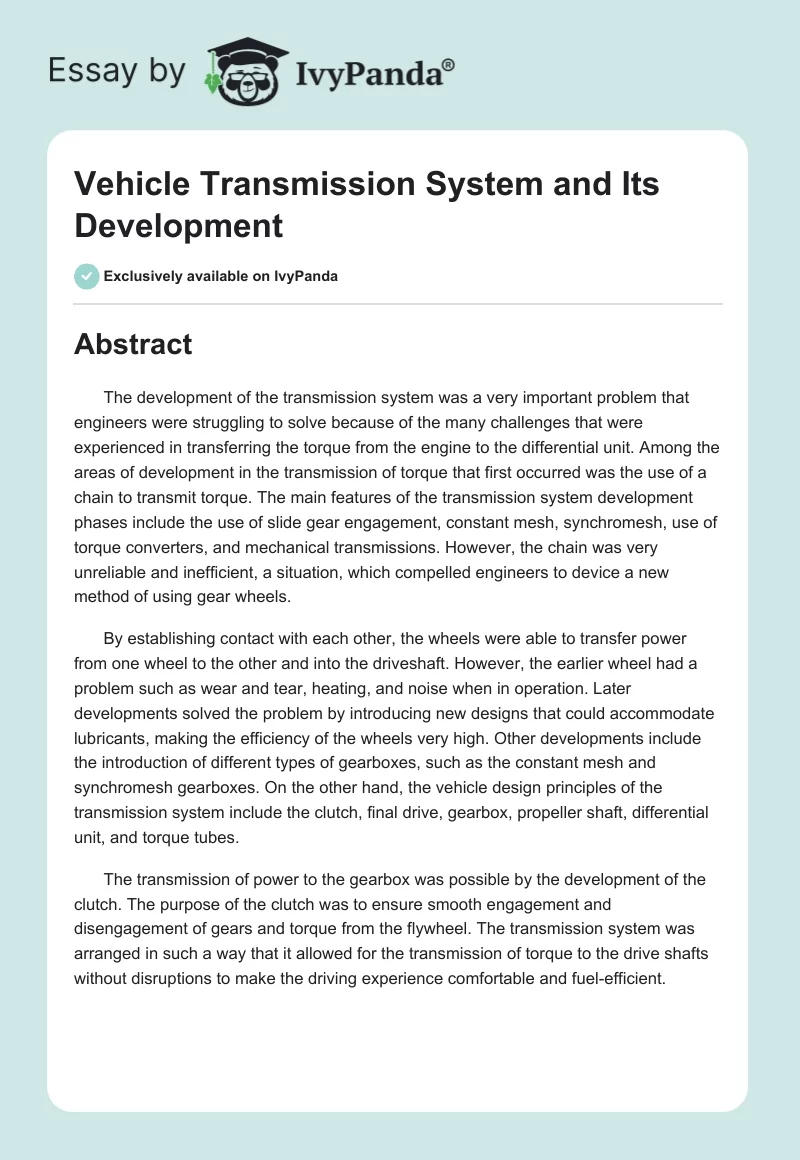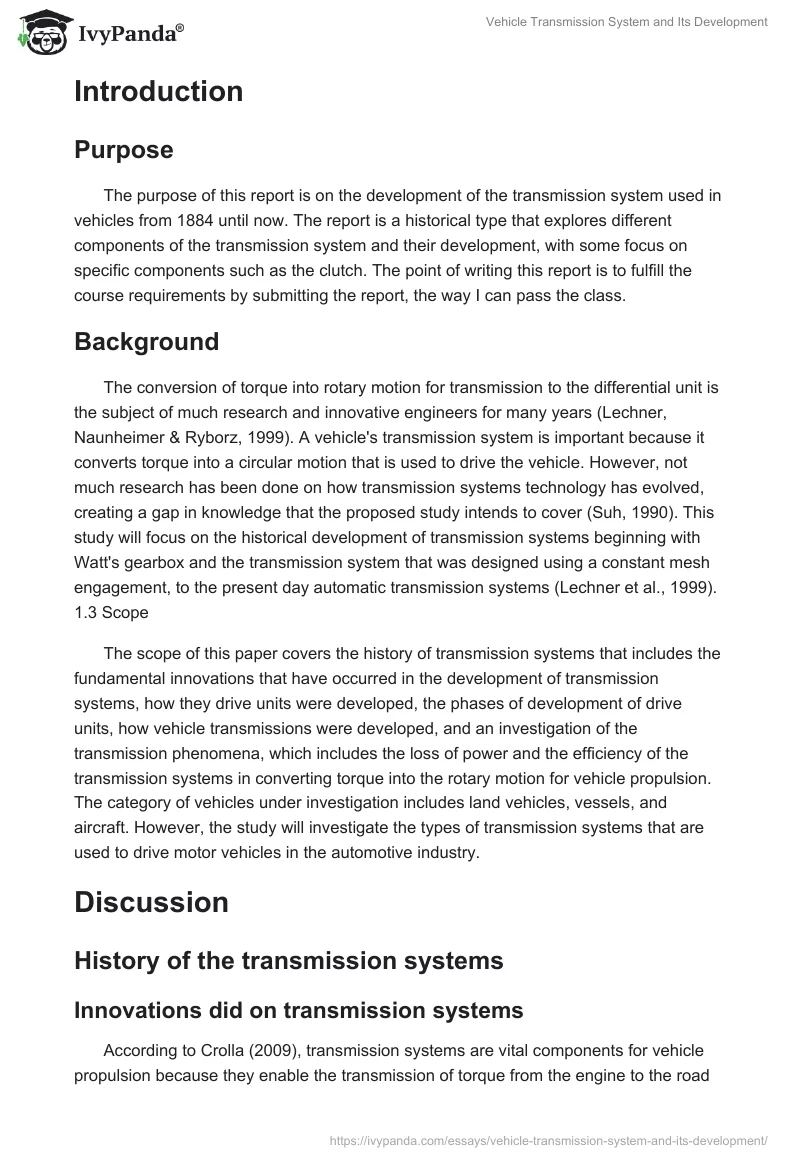Abstract
The development of the transmission system was a very important problem that engineers were struggling to solve because of the many challenges that were experienced in transferring the torque from the engine to the differential unit. Among the areas of development in the transmission of torque that first occurred was the use of a chain to transmit torque. The main features of the transmission system development phases include the use of slide gear engagement, constant mesh, synchromesh, use of torque converters, and mechanical transmissions. However, the chain was very unreliable and inefficient, a situation, which compelled engineers to device a new method of using gear wheels.
By establishing contact with each other, the wheels were able to transfer power from one wheel to the other and into the driveshaft. However, the earlier wheel had a problem such as wear and tear, heating, and noise when in operation. Later developments solved the problem by introducing new designs that could accommodate lubricants, making the efficiency of the wheels very high. Other developments include the introduction of different types of gearboxes, such as the constant mesh and synchromesh gearboxes. On the other hand, the vehicle design principles of the transmission system include the clutch, final drive, gearbox, propeller shaft, differential unit, and torque tubes.
The transmission of power to the gearbox was possible by the development of the clutch. The purpose of the clutch was to ensure smooth engagement and disengagement of gears and torque from the flywheel. The transmission system was arranged in such a way that it allowed for the transmission of torque to the drive shafts without disruptions to make the driving experience comfortable and fuel-efficient.
Introduction
Purpose
The purpose of this report is on the development of the transmission system used in vehicles from 1884 until now. The report is a historical type that explores different components of the transmission system and their development, with some focus on specific components such as the clutch. The point of writing this report is to fulfill the course requirements by submitting the report, the way I can pass the class.
Background
The conversion of torque into rotary motion for transmission to the differential unit is the subject of much research and innovative engineers for many years (Lechner, Naunheimer & Ryborz, 1999). A vehicle’s transmission system is important because it converts torque into a circular motion that is used to drive the vehicle. However, not much research has been done on how transmission systems technology has evolved, creating a gap in knowledge that the proposed study intends to cover (Suh, 1990). This study will focus on the historical development of transmission systems beginning with Watt’s gearbox and the transmission system that was designed using a constant mesh engagement, to the present day automatic transmission systems (Lechner et al., 1999). 1.3 Scope
The scope of this paper covers the history of transmission systems that includes the fundamental innovations that have occurred in the development of transmission systems, how they drive units were developed, the phases of development of drive units, how vehicle transmissions were developed, and an investigation of the transmission phenomena, which includes the loss of power and the efficiency of the transmission systems in converting torque into the rotary motion for vehicle propulsion. The category of vehicles under investigation includes land vehicles, vessels, and aircraft. However, the study will investigate the types of transmission systems that are used to drive motor vehicles in the automotive industry.
Discussion
History of the transmission systems
Innovations did on transmission systems
According to Crolla (2009), transmission systems are vital components for vehicle propulsion because they enable the transmission of torque from the engine to the road wheels via the differential unit. Suh (1990) notes that the first transmission system was developed by French inventors Louis-Rene Panhard and Emile Levassor using the chain drive that was very inefficient. However, later designs incorporated the differential axle for the rear wheels to enhance its operational efficiency. However, later transmission systems consisted of wheels that meshed and interacted with each other and rotating at the right speed to allow for the transmission of torque. The transmission system evolved through the manual, synchromesh transmission, automatic transmission, a manumatic, continuous variable, sequential manual gearbox, dual-clutch, and dual-clutch transmission systems (Lechner et al., 1999). Each transmission system was developed to ameliorate the weaknesses of the previous design, but most of the later designs are generally in use today.
Vehicle drive units
The vehicle drive units were developed to solve the problem of converting the reciprocating drive of the engine to rotary motion that could be transmitted to the differential unit. However, the historical development of the drive units was chronologically done following the development of the drive units by the Siemens company in 1886, who developed an operational drive unit based on the principles of the electric dynamo (Lechner et al., 1999).
Development phases of transmission systems
The development of the transmission system came about to solve the problem of transmitting power from the engine to the road wheels. Here, different transmission types were developed depending on the innovator (Navet, Song, Simonot-Lion & Wilwert, n.d). However, the general transmission types include the z-speed transmission that was designed in such a way that gears could mess to transmit the torque to the road wheels. Under the category of z-speed gears, there were constant mesh, synchromesh, semi-automatic, and fully automatic transmission systems. On the other hand, the continuous variable transmission system consisted of the pulley, toroidal, and hydrostatic transmissions.
Fu, Dong, Cui, and Xu (2014) maintain that the manual and semi-automatic transmission systems were designed to move in such a way that they could allow the engagement and disengagement of torque using a foot-operated clutch. On the other hand, the continuously variable type enables an automatic gearshift that could lead to better utility, reliability, and assurance of road safety. Typically, the transmission system evolved through the following stages:
- Use of slide gear engagement
- Constant-mesh transmission
- Synchromesh transmission
- Use of clutch gearbox as torque converters
- Countershaft transmission with converter
- Hydro-planetary transmission
- Mechanical transmission
For instance, the constant-mesh gearbox of the earlier transmission systems includes the Maybach-gearbox that was developed in 1889 and the Peugeot driveline in 1890. Typically, the movement of the gears was facilitated by the use of dog clutched using a taper synchronizer (Lechner et al., 1999). Because of the difficulties with the engine/gear/coaxial system, engineers adopted the engine and differential unit as the better option.
Development of gear toothed systems
The toothed gear system went through a number of modifications to address the weaknesses inherent in the old designs. One of the most important components that had been developed was the gear wheel. Here, different types of gear wheels were developed to address the operational needs of different vehicles operating under different torque conditions (Fu et al., 2014). In 1856, the index gears were developed and put into use immediately. However, because of the inefficiencies of the wheel, such as breakages and noise, they were generally replaced by ball bearing gears. In later years, new discoveries of materials and designs led to the production of the bevel gear that proved to be efficient by transmitting power quietly.
According to Lechner et al. (1999), research into the design of gear wheel in 1971 showed how the effects of the geometry of the gears and how the orientation and sliding action of the gears could be improved. The research led to the production of the elastodynamic wheel that was more efficient. In addition, later versions of gears were designed to allow the flow of lubricants in the entire gear wheel system, which significantly improved the operational efficiency of the wheels. On the other hand, a study by Lechner et al. (1999) concluded that torque converters were a new way of controlling torque transmission to the wheel that proved to be very effective and reliable. One of the recent torque converters is shown in figure 1.
The principal components of the torque converters include the circulating oil or fluid, oil return pump, blades, oil clutch, and transmission shafts that enable the component to transmit power as required. In general, the torque converter is made of four principal components, which include the transmission fluid, pump, turbine, and stator. The torque converter rotates at the engine speed because it is permanently mounted to the flywheel.
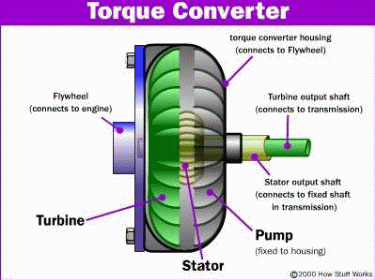
Naunheimer, Fietkau, and Lechner (2011) affirm that the transmission of torque does not require a connection between the components because the fluid serves the purpose of transmitting the torque. The presence of the torque converter enables the driveline to multiply torque to merge the difference that might arise between the input and the output system. Lechner et al. (1999) affirm that the introduction of torque converters was a significant step forward in the development of the transmission system.
Development of torque converters
According to Lechner et al. (1999), torque converters were introduced in 1940 and integrated into the vehicle transmission system to enhance the smooth transmission of torque to the road wheels. Successive generations of torque converters were modified to make the transmission of torque more efficient and to reduce any losses that occurred because of the transfer of torque among the wheels (Naunheimer et al., 2011). The 4-speed automatic transmission was one of the areas of success because the equipment operated with minimal loss of power.
Phenomena of transmission systems
A study by Naunheimer et al. (2011) concluded that engineers were able to establish the importance of transmission efficiency by showing that different designs led to different efficiencies in the transmission of torque and fuel economy. Higher efficiencies were necessary to reduce fuel consumption because of the design specifications. Naunheimer et al. (2011) and many other researchers established that reducing the weight of the transmission system reduces additional losses due to the power consumed to move the rotating parts. However, lighter designs are necessary to reduce the power auxiliary consumption and utilize it in driving the wheel.
Modern design principles are geared towards lighter and more efficient designs. However, some of the problems that lead to the power losses include design errors such as the pitch error that occurs on the spline of the gear wheel and the position error that is caused by teeth that move slightly in front of the spline. Such errors could be pronounced in earlier designs leading to transmission noise, heat, wear, inefficiency, and tilting movements.
Efficiency and power losses during power transmission
Most of the earlier transmission systems suffered significant power losses because of the design problems and materials used to make the components. In addition, most of the components used to transmit torque from the engine to the differential unit are always in constant contact. However, depending on the type of contact made between any two moving parts, the driveline could be more or less efficient. However, it is not possible to design a loss-less driveline, but a more effective one can be designed. For instance, because of the problem of power losses from the engine, because that earlier developer experienced in their designs, it was necessary for them to conduct further research to determine how best to solve the problems that were causing power losses. One of the new inventions were the invention of the gearbox and other transmission system wheel and components that allowed lubricants to flow and create a layer between the points of contact the wheel made.
Transmission design trends
Vehicle basic design principles
The design of the transmission system has evolved because of the need for a better and more efficient transmission system. Here, engineers were compelled to revise the principle upon which earlier designs were made to produce more effective designs (Naunheimer et al., 2011). The key elements that dominated later designs include the ability to offer smooth and gradual engagement and disengagement of gears, ability to transfer power in different directions and reduce the engine speed to the ratio required for higher toque production, and the ability to absorb the effects of torque due to the movement of the wheels.
Arrangement of the transmission system
The above requirements were necessary to achieve efficient transmission of torque to the wheels and were achieved by the arrangement the driveline components consisting of:
- clutch
- Final drive
- Gearbox
- Propeller shaft
- Torque tube
- Road wheel
For instance, the clutch operates on the principles of friction between two parts pressing upon one another, the size of the surface area, and the coefficient of friction between the parts in contact. Typically, the clutch gets its power from the flywheel, which is the driving member that is connected to the crankshaft, which converts the reciprocating power of the engine into rotary motion.
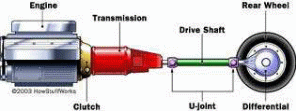
Transmission formats and designs of other components
The clutch is very important because it enables the engagement and disengagement of motion from the flywheel to other driveline units. Different types of clutches have been designed, and one of the designs is shown in figure 3. To be efficient, modern clutches were designed to be easy to operate the light in weight, provide gradual gear engagements, and be of minimum in size (Landt, 2005). Modern clutches exist in different categories, which include the semi-centrifugal clutch, single-plate clutch, diaphragm clutch, the multi-plate clutch, and the conical clutch.
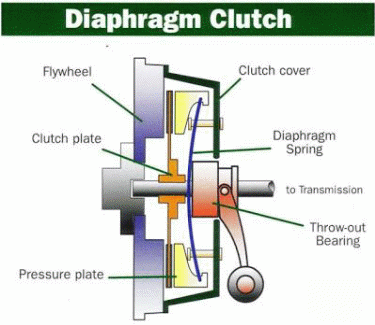
The clutch was designed with the elements of space, fuel economy, comfort, cost, and performance at heart. Typically, the design components and the relationship among the elements of the transmission system are illustrated in figure 4.

According to Wang, Li and Peng (2003), the vehicle transmission format is based on the its functions, which include enabling the vehicle to move forward, enable adaption of power, convert toque in the forward and backward directions, enable constant power transmissions, and provide a way to balance to match the power being produced by the engine. To meet the requirements and purpose for which the transmission systems are designed and integrated into the vehicle, the ancillary requirements of the transmission system includes:
- The cost of the transmission system
- Operational reliability
- Low maintenance requirements
- Easy to install
- Customizable
- Low noise and power loss
The design principles of the gearwheel transmission
Gear wheels are some of the major components used in the design of the transition system (Crolla, 2009). Engineers carefully considered the design f gearwheel to optimize their use. Some of the examples of gear wheel that is used in the assembly of the driveline are shown in figure 5.
Figure 5 shows the line of action where the driver and driven wheel interact in the transmission of torque from the drive shafts. In general, most of the wheels operate with 90% efficiency. On the other hand, the production and transfer of torque from one wheel to the other depends on the gear ratio between mating gears. Typically, the operational efficiency of a wheel depends on the pitch diameter.

On the other hand, figure 6 shows the detailed design specifications of a typical gear wheel and the parts that make contact with another wheel for the transfer of torque.
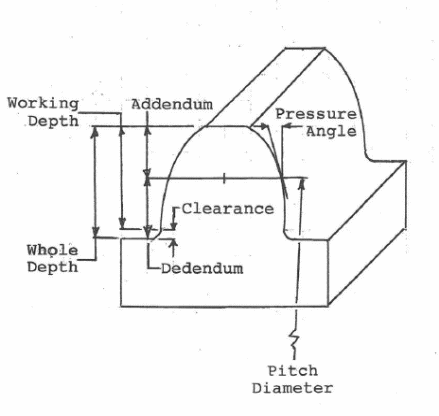
In general, the tooth size and number of wheels are measured using the pitch diameter. The module is used to measure the tooth, the circumference of the tooth is used to measure the pitch circle, and the addendum is measured using the tooth radial height. Gears come in different types in the form of spur, helical, and bevel gears. On the other hand, gears are made of different materials such as bronze, iron, and steel.
Result
The study shows that the development of the transmission system went through different stages depending on the need that could arise at the time and the problems to solve. The main areas that facilitated the need for a better transmission system include the need to be economical in terms of fuel efficiency, the lifespan of the transmission system, the efficiency of the transmission system, and the need for lighter and more reliable systems. Most of the old inventions had many problems such as loss of power, rapid wear, and tear, and heavy in weight. Despite the drawbacks that innovators went through, successive generations of designs were released with new improvements until the modern-day components that are highly reliable and efficient. In general, the transmission system went through innovations that led to the development of the manual and the automatic transmission systems.
The major components that contributed to the success of the transmission system as it is known today include the clutch, the gearbox, and the differential unit. In addition, the discovery and integration of the toque drives was a revolution to the way the transmission system transmitted torque to the differential unit from the flywheel. However, the gear wheels played a significant role in making the intermediate transmission of torque effective.
Conclusion
In conclusion, the pioneers who developed and improved the transmission systems used a lot of innovation and skills to show the need for innovation and improvements. The historical development of the transmission systems started with the simple chain, which proved very inefficient and unreliable, leading to new inventions and developments. Later developments relied on the use of the gearwheels to transmit power despite the problems that were later experienced with the use of the gear wheel.
Problems such as wear and tear, heating, and noise were experienced with the use of earlier models. To ameliorate the problems, new designs of the gear wheel were made that allowed lubricating oil to flow and form a layer between the surfaces in contact. Other developments were in gearboxes and the clutch, among others. In addition, the introduction of torque converters added to the new developments that were introduced into the transmission systems with a lot of advantages such as smooth and quiet power transmissions. In this study, it is, however, recommended that further studies be conducted on the latest transmission systems.
References
Crolla, D. A. (2009). Automotive engineering: powertrain, chassis system and vehicle body. Oxford, UK ; Burlington, MA : Butterworth-Heinemann. Web.
Fu, Y., Dong, P., Cui, L., & Xu, X. (2014). Analysis of Dynamic Characteristics of Clutch-to-Clutch Shifting Control of an Automatic Transmission. Sensors & Transducers 176(8), 262-271. Web.
Landt, J. (2005). The history of RFID. Potentials, IEEE, 24(4), 8-11. Web.
Lechner, G., Naunheimer, H., & Ryborz, J. (1999). Automotive transmissions: fundamentals, selection, design and application. Berlin; New York: Springer. Web.
Naunheimer, H., Fietkau, P., & Lechner, G. (2011). Automotive transmissions, fundamentals, selection, design and application. Berlin; London: Springer. Web.
Navet, N., Song, Y., Simonot-Lion, F., & Wilwert, C. (n.d). Trends in automotive communication systems. Proceedings Of The Ieee, 93(6), 1204-1223. Web.
Suh, N. P. (1990). The principles of design. New York : Oxford University Press. Web.
Wang, J., Li, R., & Peng, X. (2003). Survey of nonlinear vibration of gear transmission systems. Applied Mechanics Reviews, 56(3), 309. Web.

